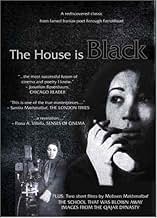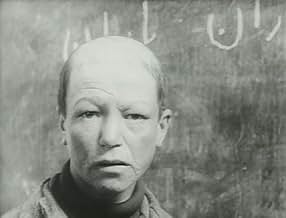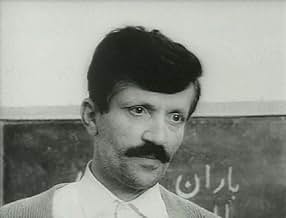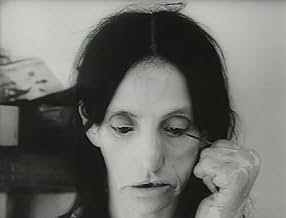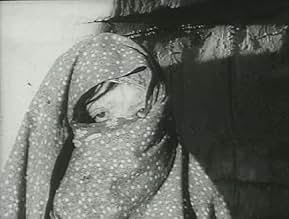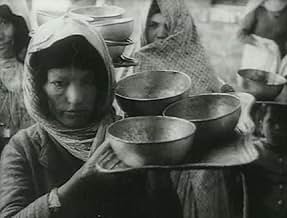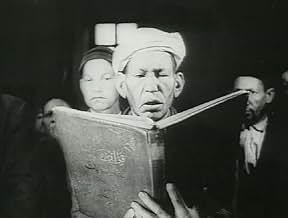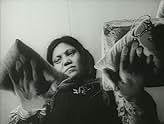Set in a leper colony in the north of Iran, The House is Black juxtaposes "ugliness", of which there is much in the world as stated in the opening scenes, with religion and gratitude.Set in a leper colony in the north of Iran, The House is Black juxtaposes "ugliness", of which there is much in the world as stated in the opening scenes, with religion and gratitude.Set in a leper colony in the north of Iran, The House is Black juxtaposes "ugliness", of which there is much in the world as stated in the opening scenes, with religion and gratitude.
- Director
- Writer
- Stars
Forugh Farrokhzad
- Narrator
- (uncredited)
Ebrahim Golestan
- Narrator
- (uncredited)
Hossein Mansouri
- Self
- (uncredited)
- Director
- Writer
- All cast & crew
- Production, box office & more at IMDbPro
Featured reviews
10evolv
One must consider why the religious emphasis is there. Everyone in this film has a message; the Iranians are known for their no frills directness when it comes to film-making.What is Farrokhzad saying about religion?
Additionally; is this film entirely about leprosy, or does it hint toward other kinds of corruption?
Is the previous reviewer certain that there were scripted scenes? I admit it's been a while so I can't clearly remember; however another rule of Iranian film is that can be very hard to distinguish the scripted and the natural. If you want to test this, check out Kiarostami's wonderful "Close-up" or Samira Makhmalbaf's "Apple". The events are real as are the actors, beyond that...well just watch em. With your thinking hat on.
OK i'm done.
Additionally; is this film entirely about leprosy, or does it hint toward other kinds of corruption?
Is the previous reviewer certain that there were scripted scenes? I admit it's been a while so I can't clearly remember; however another rule of Iranian film is that can be very hard to distinguish the scripted and the natural. If you want to test this, check out Kiarostami's wonderful "Close-up" or Samira Makhmalbaf's "Apple". The events are real as are the actors, beyond that...well just watch em. With your thinking hat on.
OK i'm done.
Masterpiece is the basis of a documentary of its time to this day.
Therefore, Iran's documentary career honor the backing of this work.
Although successful movies have been seen in the Iranian documentary cinema from the first to present day, the collaboration of Ebrahim Golestan and Dear Forough Farrokhzad with documentary subjects has largely distinguished this film.
The documentary refers to a place where lepers people are taken from quarantined villagers.
The colony of lepers living together in an enclosed environment.
The most important thing in the audience's beliefs, as the name suggests, is the mere darkness of the world of leprosy, but with a particular look it can be concluded that the general documented theme is life expectancy.
This look can be viewed from a more in-depth angle at the wedding, kids' play and classroom. Because they laugh, despite physical problems, they play and even get married.
In any case, we can not rule out that the glass of water, in addition to half empty, has full half.
Forough Farrokhzad have lived for about ten days in order to accompany and coordinate of filming, and this represents a great spirit and professional approach.
Signs indicate that the documentary has the 19th place among the fifty documentary titles in the world, in the site and sond, which is typically a special art work for Iran.
Every man is as ugly as the latter in the eyes of a beast. On the outside we are all humans. Inwardly we are all humans. Human suffering is inevitable, thus universal. As well as happiness.
Even with the high popularity of foreign cinema amongst certain groups of cinephiles, I still can't help but feel one of the many countries to get shafted is Iran and its cinematic efforts. Many countries have had some kind of "New Wave" movement in cinema, where age-old, traditionalist ideas are broken and more daring, unconventional works begin to populate the cinematic market, and Iran's New Wave seems to have gotten greatly shortchanged to being a footnote. For one thing, I consistently find myself being impressed with Iranian filmmaking, as I find that for many different audiences, especially American, it offers a window to a country many people unfairly stereotype or simplify, almost as if those residing in the country are useless subhumans. Furthermore, one of the first films in Iran's New Wave, which started in the early 1960's, was Forough Farrokhzad's twenty-minute short film The House is Black, a somber, somewhat poetic documentary fixated around the Behkadeh Raji leper colony, the first of its kind in Iran. Farrokhzad films various patients in this leper colony, with occasional narrations talking about the treatment for the disease and how these colonies - while initially seeming like isolationist practices - have actually helped out in treating this disease. Leprosy is a condition that greatly affects the skin, can result in the numbing of senses, the deterioration of your immune system, and even body parts like toes and fingers to shorten and become stunted. While it's an ugly disease, Farrokhzad dares explore the beauty of human condition in The House is Black, placing a magnifying glass on this specific colony, while emphasizing that there is all different kinds of beauty in the human race. Punctuated by readings of the Old Testament, the Muslim holy-book the Qur'an, and even original poetry by Farrokhzad, The House is Black treads similar ground to the lengthy, American-made documentaries by industry-veteran Frederick Wiseman, who has erected his career off of observational documentaries on some of the most elusive institutions such as a mental hospital, a horse-racing track, and institutes that help the mentally-handicapped. Here is a film that kicks off a colossal, revolutionary movement in cinema and can be talked about on a level that isn't simply adhering to its technical innovations but its story and its commentary on human beauty and the diversity that plagues it.
Directed by: Forough Farrokhzad.
Directed by: Forough Farrokhzad.
This short makes my top 30 favorite films of all time. I didn't expect to love it as much as I did when I first saw it considering how poor the quality of the film is (in fact, there are a couple points where I can't make out the subtitles in the film due to how they blend in with the background). Given this, what did it do to impress me so much?
The line "Leprosy is not incurable" is repeated twice throughout an opening sequence which states facts about leprosy, almost as if to make sure the meaning of that line isn't lost concerning the grisly images we see of the people with the disease. Considering how the narrator points out how other people with the disease were cured when treated for it, this monologue also indicates that all the people we see suffering in the film could be cured of this disease. It's just that the government failed to take care of them as, instead of solving the problem, they herded them into the colony documented in the short, leaving them to further deteriorate. Instead of this scene coming off as preachy, this unspoken message is implied rather than directly stated, making for a really powerful scene. Regardless of whether you pick up on this implication or not, it still manages to get under your skin.
Farrokhzad also does a great job at exploring the ironies of the daily lives of the people in the colony, specifically with religion. Multiple sequences indicate that religion is a major part of their cultures. In one scene, a group of kids thank God for giving them hands, eyes, and ears - features which many people in the colony don't have. In another powerful moment, a man holds his withered hands in the air and refers to hands while reciting a prayer. This is followed by a sequence which cuts between a group of people practicing religion and several shots of people with deformed body parts which were brought about due to the disease, in turn creating tension with this editing technique. The viewer can't help but wonder why all these people thank God for giving them gifts which many of them don't have. It seems likely that religion is an abstract concept in their lives and they don't think much about the words and prayers they say.
In addition, a few sequences in the film stick out to me as especially powerful. The first of which shows a couple women putting on makeup and brushing their hair. This scene shows how, in spite of their facial and bodily features, many of the people in the colony still make an effort to look "beautiful", as if their goals are to connect with their past lives or to find light in such a depressing environment. Another scene shows a group of boys playing ball together. Unlike a number of the older people we see in the colony, their mobility doesn't seem to be effected by their disease. Despite this though, the grotesque facial features of a number of them are hard to ignore and, considering how the shot which immediately follows this sequence shows a man with one leg slowly walk down a path with the help of crutches, the short seems to suggest that those boys will grow up with further suffering and that they won't be able to experience moments like this unless they're cured of their disease (one effective shot which occurs earlier in the film shows a man giving his crutch to a boy to play with). One final scene worth mentioning is the classroom scene at the end. Something about this scene, specifically some of the answers the boys give to their teacher, makes it feel staged. It just seems too suited for the messages Farrokhzad wants to send to have naturally occurred. While I usually find staged scenes like this to be jarring in documentaries, I didn't mind it so much in here as it's still able to make for a devastating critique of religion.
Overall, this is a perfect short. Instead of solely raising awareness for the issue documented in it, Farrokhzad has several artistic points which she incorporates into the dialogue and the visuals of the film quite flawlessly as many of them are subtle or implied rather than directly stated. Sadly, Farrokhzad died shortly after this film was released, making this the only film she directed. Who knows what else she could've given us? However, this film will forever stand as a masterpiece to me and, if you can get by the occasional issues with the subtitles, you're in for a great treat with this one.
The line "Leprosy is not incurable" is repeated twice throughout an opening sequence which states facts about leprosy, almost as if to make sure the meaning of that line isn't lost concerning the grisly images we see of the people with the disease. Considering how the narrator points out how other people with the disease were cured when treated for it, this monologue also indicates that all the people we see suffering in the film could be cured of this disease. It's just that the government failed to take care of them as, instead of solving the problem, they herded them into the colony documented in the short, leaving them to further deteriorate. Instead of this scene coming off as preachy, this unspoken message is implied rather than directly stated, making for a really powerful scene. Regardless of whether you pick up on this implication or not, it still manages to get under your skin.
Farrokhzad also does a great job at exploring the ironies of the daily lives of the people in the colony, specifically with religion. Multiple sequences indicate that religion is a major part of their cultures. In one scene, a group of kids thank God for giving them hands, eyes, and ears - features which many people in the colony don't have. In another powerful moment, a man holds his withered hands in the air and refers to hands while reciting a prayer. This is followed by a sequence which cuts between a group of people practicing religion and several shots of people with deformed body parts which were brought about due to the disease, in turn creating tension with this editing technique. The viewer can't help but wonder why all these people thank God for giving them gifts which many of them don't have. It seems likely that religion is an abstract concept in their lives and they don't think much about the words and prayers they say.
In addition, a few sequences in the film stick out to me as especially powerful. The first of which shows a couple women putting on makeup and brushing their hair. This scene shows how, in spite of their facial and bodily features, many of the people in the colony still make an effort to look "beautiful", as if their goals are to connect with their past lives or to find light in such a depressing environment. Another scene shows a group of boys playing ball together. Unlike a number of the older people we see in the colony, their mobility doesn't seem to be effected by their disease. Despite this though, the grotesque facial features of a number of them are hard to ignore and, considering how the shot which immediately follows this sequence shows a man with one leg slowly walk down a path with the help of crutches, the short seems to suggest that those boys will grow up with further suffering and that they won't be able to experience moments like this unless they're cured of their disease (one effective shot which occurs earlier in the film shows a man giving his crutch to a boy to play with). One final scene worth mentioning is the classroom scene at the end. Something about this scene, specifically some of the answers the boys give to their teacher, makes it feel staged. It just seems too suited for the messages Farrokhzad wants to send to have naturally occurred. While I usually find staged scenes like this to be jarring in documentaries, I didn't mind it so much in here as it's still able to make for a devastating critique of religion.
Overall, this is a perfect short. Instead of solely raising awareness for the issue documented in it, Farrokhzad has several artistic points which she incorporates into the dialogue and the visuals of the film quite flawlessly as many of them are subtle or implied rather than directly stated. Sadly, Farrokhzad died shortly after this film was released, making this the only film she directed. Who knows what else she could've given us? However, this film will forever stand as a masterpiece to me and, if you can get by the occasional issues with the subtitles, you're in for a great treat with this one.
Did you know
- TriviaIt was the only film Farrokhzad directed before her death in 1967. During shooting, she became attached to a child of two lepers, whom she later adopted.
- ConnectionsFeatured in Cinema Iran (2005)
Details
- Release date
- Country of origin
- Language
- Also known as
- The House Is Black
- Filming locations
- Production company
- See more company credits at IMDbPro
- Runtime20 minutes
- Color
- Sound mix
- Aspect ratio
- 1.37 : 1
Contribute to this page
Suggest an edit or add missing content

